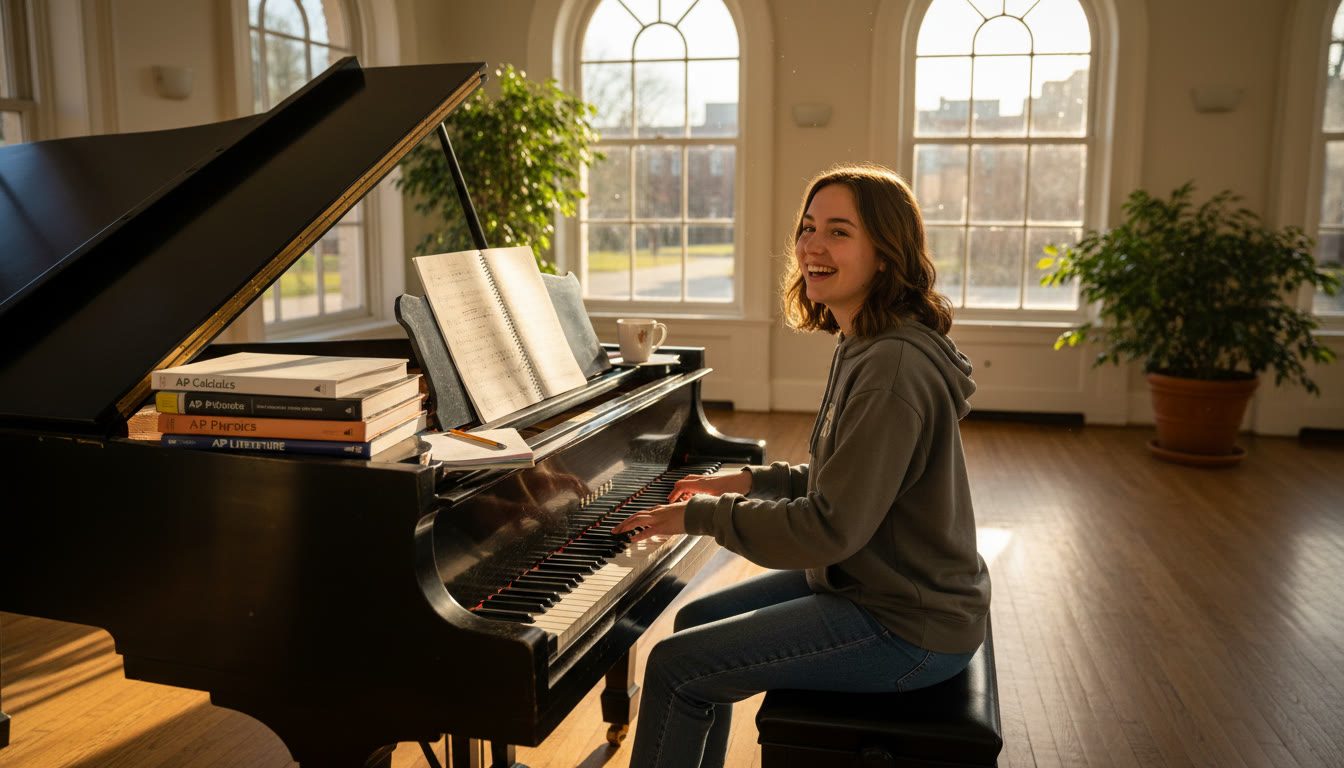Oberlin: APs and Conservatory Dreams — An Overview
Applying to Oberlin when you’re passionate about both rigorous academics and serious music or art training is thrilling — and a little bit complicated. Oberlin College and the Oberlin Conservatory offer a unique pathway: you can pursue a liberal arts education alongside conservatory-level artistic training. That dual identity invites questions that many students and parents have: How do AP classes fit into an application that also needs audition recordings and portfolios? Should you prioritize APs or focus on your craft? How can you present a clear, compelling story that blends both?
Why this balance matters
Oberlin’s combined environment rewards both intellectual curiosity and artistic commitment. Admissions committees look for academic preparedness—APs can be evidence of that—while conservatory admissions care deeply about your demonstrated artistic potential. The goal is to show that you’re not dividing yourself aimlessly, but intentionally integrating two complementary parts of your profile.

How Admissions Read APs for Dual-Track Applicants
AP courses tell an admissions officer a few things: you seek rigor, you can manage time, and you’ve sampled college-level material. For Oberlin applicants aiming at Conservatory programs, APs are valuable but not decisive. Artistic auditions and portfolios will usually outweigh test-credit considerations in conservatory admissions; however, strong APs strengthen your overall academic narrative and reassure the College admission side that you can handle Oberlin’s intellectual demands.
Which APs carry the most weight?
- AP Music Theory — Highly relevant for conservatory applicants; shows formal musical training and theoretical knowledge.
- AP Studio Art (2D/3D/Draw) — Crucial for visual arts applicants who will submit portfolios; demonstrates formal art coursework and an ability to present visual work in a focused way.
- AP Calculus, AP Biology, AP Chemistry, AP Physics — Valuable for applicants interested in double-majoring or taking rigorous coursework in the sciences or math alongside music/art.
- AP English Language/Literature — Useful for demonstrating strong communication and critical thinking; helpful if you plan to write thoughtful program notes, essays, or research about your art.
Practical Strategy: Choosing APs When You’re Also a Conservatory Applicant
Remember: quality beats quantity. Four to six well-chosen APs taken over junior and senior year—especially those that align with your interests—are typically more persuasive than a scattershot schedule.
Guidelines to build your schedule
- Prioritize APs that support your intended college studies. If you’re a music major who loves physics, AP Physics supports both intellectual curiosity and potential cross-discipline work (acoustics, audio engineering).
- Take AP Music Theory if available — it’s directly useful for Conservatory applications and auditions.
- Keep at least one semester light in senior year to prepare audition repertoire or refine your portfolio; conservatory work is time-consuming and performance-quality matters.
- If your school offers honors or dual-enrollment courses more tailored to your craft, weigh those against APs; sometimes a focused conservatory-prep program is more relevant than an unrelated AP.
Preparing the Conservatory Application Side
Conservatory admissions at places like Oberlin look for artistry, technical ability, and musical or visual maturity. That means your audition recordings, live audition (if required), composer/performer resumes, and portfolios need professional attention. Treat these components as part of a multi-year artistic project, not an afterthought in senior year.
Actions that move the needle
- Start preparing audition repertoire a year in advance — many successful applicants begin shaping their program in junior year.
- Record high-quality audition videos or schedule live pre-screenings. Technical polish matters: good lighting, clear audio, and minimal distractions help the listener focus on your performance.
- For visual artists, curate a portfolio that shows range and a coherent voice. It’s better to show 12–20 strong pieces than 40 mediocre ones.
- Include program notes, short artist statements, or annotated scores when appropriate — these contextualize your work and show intellectual engagement.
How to Tell a Cohesive Story in Your Application
Your application should read like a compelling narrative: here’s who I am academically; here’s how music/art shapes my intellectual life; here’s how I’ll contribute to Oberlin. That story connects AP coursework and artistic practice rather than presenting them as competing priorities.
Examples of coherent narratives
- A pianist who took AP Music Theory, AP Literature, and AP Psychology to explore interpretation, language of music, and performance psychology — showing both craft and intellectual curiosity.
- A visual artist who balanced AP Studio Art with AP Environmental Science to inform eco-themed installations — illustrating interdisciplinary thinking.
- A composer who paired AP Calculus, AP Physics, and AP Music Theory to pursue acoustic modeling or the math of sound — signaling a clear academic-artistic plan.
Table: Example Senior-Year Plans for Three Applicant Profiles
| Profile | APs Taken | Senior Year Focus | Conservatory Prep |
|---|---|---|---|
| Performance Major (Piano) | AP Music Theory, AP English Literature, AP Psychology | Light course load + AP Exam prep; advanced literature seminar | Refine 30–40 min audition program; high-quality recordings |
| Composition Major | AP Calculus, AP Music Theory, AP Computer Science (if available) | Balance APs with independent composition project | Submit scores and recordings of original works; portfolio website |
| Visual Arts Major | AP Studio Art, AP Biology (for material research), AP English | Senior portfolio consolidation; college essay writing | Curate 12–20 portfolio pieces; professional photos of sculptures/installations |
AP Exams and Credit: How to Use Scores Strategically
AP credit policies vary by institution and department. Even where AP credit is limited, strong AP scores still testify to your academic rigor. For Conservatory students, AP scores are rarely the deciding factor — the conservatory will prioritize audition and portfolio quality. But on the College side, APs can help with placement and may open space in your first-year schedule for studio lessons or ensemble commitments.
Practical tips about AP exam timing
- Take the AP exam only if your score will add tangible value: for placement, credit, or demonstrating mastery of an academic area.
- If you’re stretched thin preparing audition repertoire, it’s acceptable to limit the number of AP exams you take—quality over quantity.
- Consider taking some APs earlier (sophomore or junior year) so senior year can emphasize auditions, capstone artistic projects, or portfolio refinement.
Essays, Recommendations, and Supplemental Materials
Your written voice and recommender perspectives should reinforce the same story: you’re academically capable and artistically driven. Use essays to explain how your artistic practice emerges from and informs your intellectual interests.
What to ask recommenders to emphasize
- For an academic teacher: insights into your intellectual curiosity, classroom contributions, and readiness for Oberlin’s academic rigor.
- For a music/arts teacher or private instructor: specifics about your technical development, rehearsal ethic, collaborative strengths, and growth trajectory.
- If possible, include a recommender who speaks to your ability to balance demanding schedules — this directly addresses concerns about managing studio, practice, and AP coursework.
Time Management: Practice, APs, and Life
The practical reality is this: conservatory-level practice is time-intensive. Sustained progress comes from consistent daily practice, deliberate plateaus, and well-timed rest. Combine that with AP study, and you need a realistic calendar.
Weekly scheduling template (sample)
- Daily practice blocks: 1.5–3 hours (split into focused, goal-oriented sessions).
- AP study: 5–8 hours per week per AP during intensive months; less during plateau months focused on repertoire.
- Rest and wellbeing: 4–7 hours weekly dedicated to non-academic, non-practice activities to prevent burnout.
How Personalized Tutoring Can Help — Naturally
Juggling conservatory preparation and AP demands is easier with tailored support. Personalized tutoring, like Sparkl’s 1-on-1 guidance, can provide focused study plans, targeted practice strategies, and expert feedback on essays or audition recordings. Tutors who understand both the AP landscape and conservatory expectations can match lesson plans to your timeline — helping you maximize AP performance without sacrificing artistry.
What to expect from targeted tutoring
- Customized study schedules that align AP exam dates with audition recording deadlines.
- Expert tutors who give actionable practice feedback, score analysis for AP classes, and essay coaching focused on your artistic narrative.
- AI-driven insights to track progress and optimize study efficiency, paired with human mentorship for emotional support and artistic critique.
Auditions and Portfolios in the Age of Digital Submission
Recording technology gives applicants opportunities to present themselves at their best. Treat recordings seriously: invest time in capturing great sound and clear visuals. For portfolios, invest in high-resolution photos and concise descriptions that explain process, materials, and intention.
Technical checklist for recordings and photos
- Audio quality: use a decent microphone or a conservatory-standard recording setup; avoid phone-only audio unless it’s high quality.
- Visuals: stable camera, neutral background, good lighting; frame the performer or artwork clearly.
- Documentation: include timestamps or indexes for multi-piece submissions and short program notes when appropriate.

Financial Aid, Scholarships, and Conservatory Funding Considerations
Conservatory training can be expensive, and Oberlin does offer financial aid and merit scholarships. When planning, be proactive: apply for financial aid early, gather documentation, and, if possible, ask the conservatory about talent-based awards. Some auditions or portfolio submissions are considered for institutional scholarships; be sure your application materials reflect both artistic and academic strength.
Steps to strengthen your financial aid profile
- Submit FAFSA and institutional financial aid forms by their deadlines.
- Prepare a clear artistic resume outlining lessons, ensembles, awards, and leadership roles — it helps both admissions and scholarship committees assess impact.
- Inquire about conservatory-specific scholarships once your application is complete — sometimes additional materials can support scholarship consideration.
Final Checklist Before You Submit
Give yourself a pre-submission audit to ensure everything aligns with your story and is technically polished.
Pre-submission audit items
- Academic transcript: Are AP courses and grades highlighted in context? Is your school counselor’s note helpful?
- Audition/portfolio: Highest-quality recordings and images, properly labeled and within time limits.
- Essays: Do they interweave your artistic and academic interests naturally? Have you shown growth and future plans?
- Recommendations: Do they reinforce your narrative and address both scholarly and artistic qualities?
- Testing and AP scores: Submitted where helpful, but not at the expense of audition prep.
Parting Advice: Think Like a Curator, Not a Collector
Applying to Oberlin as an AP student with conservatory ambitions is about curation: choose APs that strengthen your intellectual profile, craft a portfolio or audition that shows clear artistic voice, and tell a cohesive story. Admissions committees want to see dedication and direction — not just a résumé of activities. Give them depth, show how AP learning enriches your art (and vice versa), and present materials that are technically excellent and emotionally honest.
One last tip
Start early, plan deliberately, and use personalized support where it makes sense. Whether it’s a focused AP review plan, feedback on performance recordings, or essay coaching, targeted help (for example, Sparkl’s personalized tutoring that blends 1-on-1 guidance with tailored study plans and expert tutor feedback) can be a practical investment to keep your application polished and authentic.
Above all, enjoy the process. The intersection of academic curiosity and artistic practice is a rare and wonderful place to be — and Oberlin is one of the few institutions that will celebrate both sides of your creative-intellectual identity. Put time into making your best work, then let it speak for itself.
























No Comments
Leave a comment Cancel